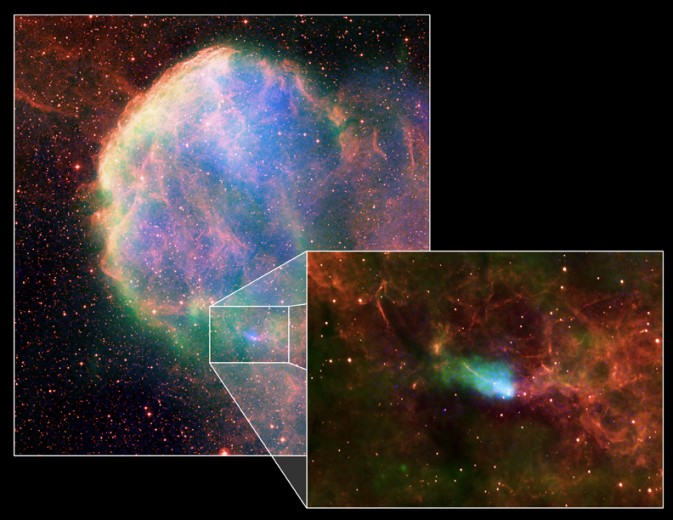Credit & Copyright: Chandra X-ray:
NASA/CXC/B.Gaensler et al;
ROSAT X-ray: NASA/ROSAT/Asaoka & Aschenbach;
Radio Wide: NRC/DRAO/D.Leahy; Radio Detail: NRAO/VLA; Optical: DSS
Explanation:
IC 443 is typical of the
aftermath
of a stellar explosion, the ultimate fate of massive stars.
Seen in this
false-color composite image, the
supernova remnant is still glowing
across the spectrum,
from radio (blue) to optical (red) to x-ray (green) energies --
even though light from the stellar
explosion that created the expanding cosmic cloud first
reached planet Earth thousands of years ago.
The odd thing about IC 443 is the apparent
motion of its dense
neutron star, the collapsed remnant of the
stellar core.
The close-up inset shows the swept-back wake created as the neutron star
hurtles
through the hot gas, but that direction
is not aligned with the direction toward the apparent center of
the remnant.
The misalignment suggests that the
explosion site was offset
from the center or that fast-moving gas in the nebula has
influenced the wake.
The wide view of IC 443, also known as the
Jellyfish nebula,
spans about 65 light-years at the supernova remnant's
estimated distance of 5,000 light-years.
Radio Wide: NRC/DRAO/D.Leahy; Radio Detail: NRAO/VLA; Optical: DSS
1999 2000 2001 2002 2003 2004 2005 2006 2007 2008 2009 2010 2011 2012 2013 2014 2015 2016 2017 2018 2019 2020 2021 2022 2023 2024 2025 |
Yanvar' Fevral' Mart Aprel' Mai Iyun' Iyul' Avgust Sentyabr' Oktyabr' Noyabr' Dekabr' |
NASA Web Site Statements, Warnings, and Disclaimers
NASA Official: Jay Norris. Specific rights apply.
A service of: LHEA at NASA / GSFC
& Michigan Tech. U.
|
Publikacii s klyuchevymi slovami:
supernova remnant - neutron star - ostatok Sverhnovoi - neitronnye zvezdy
Publikacii so slovami: supernova remnant - neutron star - ostatok Sverhnovoi - neitronnye zvezdy | |
Sm. takzhe:
Vse publikacii na tu zhe temu >> | |
